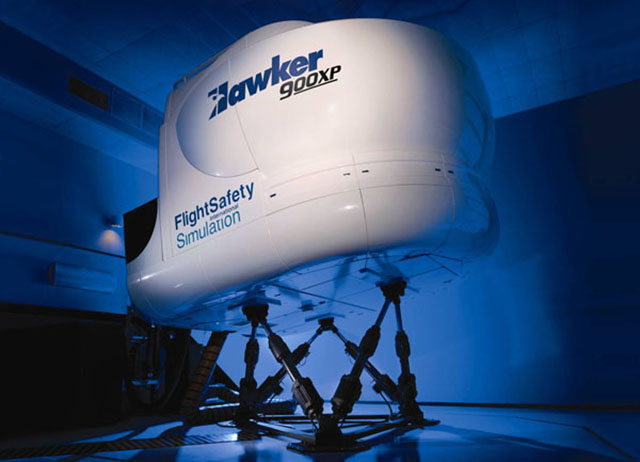So, you’ve hired a new pilot, or perhaps a new pilot has been hired for you and now it is up to you to make everything work out smoothly. Either way, as the person in charge, you need to have a plan to get the new hire up to speed.
— James Albright

Updated:
2022-06-15
You also need to be ready for the many pitfalls ahead. It is all too common for the boss to think it is up to the new hire to fit in. While much of the responsibility is on your new hire’s shoulders, it is also up to you and the rest of the organization to make the smooth transition possible.
2 — Introducing the new pilot to the flight department
3 — Sending the new pilot to school
4 — Getting the new pilot up to SOP speed after initial training
5 — Motivating the new pilot to excel
6 — Motivating the "troops" to help
7 — Epilogue: the new pilot is assimilated and asserting him or herself

1
Meeting the new pilot
You have probably heard that “you only get one chance to make a good first impression” and that the “first impression is the last impression.” Remember this goes two ways: the new hire will be forming a lasting first impression about you and the organization.
Their expectations versus your objectives
If you’ve been in the “boss category” for a while, you probably have a refined ability to size up a newly hired pilot very quickly. If you are new to all this, you might be more openminded and can see past a first bad impression. But in either case, your opinions about the person will begin to set. This can be unfortunate if those first impressions are wrong. You should realize that the new hire is also making a similar judgement about you and the organization.
In both my military and civilian lives as the person doing the hiring and firing, I’ve benefitted by the fact my organizations attracted good talent and there were no shortages of qualified volunteers. But I also learned very quickly that it is easier to hire than fire, and that it takes years of development to bring a newly hired pilot up to the qualifications of a recently departed pilot. Getting the pilot hired is only the first step in a very long process. You want to get the pilot qualified, upgraded, and productive to the point you can assign that pilot a duty and consider it done. All of this begins with the first handshake.
The new hire’s objective for that first meeting is to assure you that the hiring process did a good job. Your objective should be to instill into the pilot that he or she made a good decision coming to work for you and that extra effort in upcoming training will be rewarded. I’ve seen many chief pilots fail in these efforts because they assumed they had the upper hand during the first meeting and that all the pressure was on the new hire. In fact, it is the other way around.
Potential pitfalls
Every now and then I came away from meeting a new boss thinking that I struck gold and it was going to be a real privilege to join the organization. More often, unfortunately, I wondered if the boss was having a bad day, at best, or that I was about to join a group of misfits. The best way to avoid souring your new hire’s impression of you and the organization, is to replay your most recent introduction but in the shoes of the new hire. What impression would you have made? More importantly, how could you have improved upon it?
- The “I am better than you and I want you to know that” first impression. This usually happens with the boss looking over a new hire’s resume and giving a live critique comparing experience levels. “I was multi-rated when I turned eighteen,” the boss could say. “How many oceanic crossings have you had? Well, don’t worry, we’ll get you up to speed.” These jabs can be well intentioned, of course, but they telegraph to the new hire that they will be on the defensive from day one. That is hardly the best way to start a new job.
- The “I am going to be your new best friend” first impression. Most flight departments are led by pilots with very little leadership training and some of these bosses can be overwhelmed by the idea they are in charge of anything or anyone. A common reaction is to deny the elevation and attempt to remain as “one of the guys.” “I’m just another pilot,” they might say, “everybody has the same pull around here.” When the person in charge refuses to take charge, the result is often chaos.
- The “I am too busy to deal with peons like you” first impression. “Just do your job and you won’t have any problems with me,” the chief pilot might say, “dealing with corporate is a full-time job, don’t you know.” I heard this once from a “chief pilot” who had business cards proclaiming the position as well as a snazzy desk plate with his name and title in gold letters. It was all I could do to restrain open laughter at the thought he was in charge of just two other pilots and a mechanic. In the next year I learned he was reluctant to share information but quick to delegate tasks he thought beneath his lofty position.
- The “I just want to make it to retirement” first impression. “Let’s cooperate and graduate,” the boss might say. “We have a good gig here and let’s not spoil it with a lot of whining or second-guessing of the ways things have always been.”
These are just a few examples of how you can make a bad first impression, but there are many others. I liken these leadership situations to parenthood. No amount of training can adequately prepare you. Actual experience is the best teacher. Once you’ve figured it out, you are done. But unlike parenthood, you have many opportunities to improve. The only way to do that is to be self-critical and to objectively critique yourself after every first meeting.
Success strategy
As with many things in the boss-to-subordinate relationship, all meetings should have an objective in mind and the boss should think through how his or her conduct will further the objective. You want to reassure the new hire that coming aboard was a good decision. You want to arm them with the needed information to excel during training. You want to begin the process of acclimating the new hire to the rest of the flight department. And you want to do all this as if it is a natural, organic process. They are joining a smoothly operating organization, after all!
2
Introducing the new pilot to the flight department
Their expectations versus your objectives
When the new hire meets their new peers, they hope to get a glimpse into the world they are joining, perhaps learn a bit about the organization, and get whatever pearls of wisdom they have to offer about the airplane and the operation. If any of the group had been scarred by their experiences as new hires in your organization, they might also be on the defensive and can telegraph their ill will to the newest new hire.
You want your new hire to meet your best people, those you can be sure will paint the new environment in a positive light and will be helpful to the new hire’s transition. Don’t let this happen by random chance; make sure your best people are available for the new hire’s first day on the job.
Potential pitfalls
Some new hires take on accentuated personalities when in stressful situations. A naturally quiet person can be reclusive. A naturally talkative person can become overbearing. These reactions to a new environment can be off-putting and set things off on the wrong foot.
Some people in your flight department can attempt to establish what canine trainers call “alpha dominance” when meeting a new pilot. All your good work in setting the right tone can be undone by one or two pilots determined to establish themselves as the real powers to be reckoned with in the new hire’s world.
You may be surprised that some in your flight department have deep-seated prejudices against certain types of pilots. As archaic as it may sound, I still encounter pilots who vow to never fly with female pilots. This kind of animosity isn’t limited to sex or race. In my first civilian job, I was paired with a pilot who spent the first hour of our flight to Europe talking about how military pilots have no place in civilian aviation because we never earned our hours. He kept this up until I told him I had been an Air Force pilot for twenty years. “Well, you are the exception, then.”
Success strategy
You cannot hide the bad actors in your flight department for long, but there is a way to ensure the new hire and the older pilots all react well to each other. Do your best to introduce your new hire to the best people in the flight department early. Think of those you wouldn’t worry about having dinner with the company CEO. Save any troublemakers for after the new hire returns from school.
Once the new hire returns from school, he or she will have earned some credibility and confidence. Any troublemakers will have a harder time “blowing smoke” about the aircraft or training.
3
Sending the new pilot to school
Their expectations versus your objectives
It is only natural for a new hire to be nervous about an upcoming training event. “Will it be harder than anything I’ve done before?” “What if I don’t pass the check ride?” You want the new hire to excel, of course. But what can you do now, before training?
Potential pitfalls
Most of us make lousy ambassadors for the training process. We tend to over- or under-state the difficulty, or our memories give totally inaccurate advice. I’ve gone through this new aircraft training process many times, and I think the advice was appropriate three or four times at most. Here are some examples of the worst advice:
- “It was the toughest check ride of my career,” I was once told before going to initial training. “I felt lucky to pass. Don’t feel bad if you don’t pass, most of us don’t.” That was not what I wanted to hear! And it wasn’t true.
- “Make sure you visit local restaurants,” I heard for another initial. “It would be a shame to miss out on all that excellent food. School is easy, they will teach you the check ride.” That was bad advice.
- “There’s no way to prepare, so why even bother? They give you all the study materials on the first day, so you know they don’t expect you to waste your time before class.” This vendor did indeed train the check ride but showing up more prepared would have made me more able to separate the wheat from the chaff spewed by the person wearing the instructor name tag.
Training experiences are often eclipsed by actual flying experiences and many people simply “flush” the earlier memories. If they offer any advice at all, it may be dated and no longer applicable.
Having been a victim of this kind of bad advice over the years, I have tried to analyze the motivation of the advice givers. I think some were well intentioned and thought minimizing the challenge would set my mind at ease. (It had the opposite effect.) I know that some barely passed because they were poorly prepared and, I suspect, wanted me to experience what they had endured. No matter the motivation, bad advice is poisonous and can set your new hire up for failure.
Success strategy
The best way to set up your new hire for a positive training experience is to learn from the most recent graduate. I like to sit down with returning trainees twice, once before they start flying the line and again after a month or so of line experience.
An interview immediately upon return and before the new hire starts line flying ensures the answers are fresh and not impacted by the inevitable learning process that happens “out there” in the real world.
- Did your classroom time prepare you well for the written and oral exams? Which questions gave you the most trouble, try to recall them as best you can.
- Are any of the aircraft systems or flight procedures unusual compared to what you’ve flown in the past? How so?
- Did the task trainers and simulators prepare you well for the flight check? Recall the check ride scenario as best you can, with an eye towards helping the next pilot we send.
- Who were your instructors, and did they adequately train you given the amount of time, or did they waste your time?
- Which study guides or other reference materials did you find especially helpful? How can we adopt them for our use in house?
- Did the training prepare you for written, oral, or flight evaluations? How could the training have been better and how can we make up for these deficiencies for the next person we send?
After the new hire has flown a few trips and is showing signs of getting comfortable, but no more than two months after training, it is time for another interview.
- Based on what you’ve seen so far, which normal flight procedures didn’t get enough attention? How could they have made your transition to flying the line with us smoother?
- Did you feel “behind the power curve” when dealing with any aircraft systems flying the line because it wasn’t covered with enough detail (or at all) in school?
- Let’s go through a normal flight from exterior preflight inspection all the way to securing the aircraft from flight. (Use the appropriate checklists.) For each, what do we do on the line that should have been covered with more detail during training?
- Do you have any advice for the next new hire?
4
Getting the new pilot up to SOP speed after initial training
Their expectations versus your objectives
Many aviators are comfortable with Standard Operating Procedures (SOPs) and expect them in all phases of any quality flight organization. Many, but not all. Some, in fact, are openly hostile to the idea that someone else will have anything to say on how they fly their aircraft. With these pilots, it may take a while for their true nature to come out, but it will come out. That can be poison for your organization. An “SOP denyer” has two possible courses in your organization: they can be converted early or not at all.
Potential pitfalls
If your crews tend to fly without any standardization, an early push for the new hire to adopt SOPs will not last long. Even if all the other pilots do faithfully enforce your organization’s SOPs, if they don’t teach them the new hire may see them as optional. Finally, if the new hire hasn’t been exposed to a rigid set of SOPs before, he or she will be tempted to give them up unless they are consistently and regularly used by everyone.
Success strategy
The new hire needs to understand why SOPs are vital to fully embrace them. When flying with multiple crews, it is important that everyone understand what “normal” looks like so they can better identify the abnormals. This is even more important when flying with only one other pilot; two pilots who fly exclusively together can go down the path of intentional procedural noncompliance without even knowing it.
The boss should let the new hire know that SOPs can and should change over time, but that is done in a thoughtful and well considered way. I’ve given this speech so many times that I have it memorized. “You come to us with a lot of experience, and we are looking forward to hearing what you think about how we do things around here. We rely on everyone flying by the book, as defined by the AFM and the many regulations that spell out what must be done. We also embrace a lot of technique that makes everything easier and more predictable. But we standardize those techniques to increase the amount of back up everyone provides to everyone else. It could be that you have a better way of doing things. Please hold your fire and see how we do it first. Then, after seeing that, come see me and let me know how we can do it better. We’ve adopted many new SOPs, in fact the last one was . . .” (And provide that example.)
5
Motivating the new pilot to excel
Their expectations versus your objectives
The new hire wants to achieve his or her objectives, which may not be the same as your objectives. Ideally, the objectives are the same. But even if they are not, you might be able to satisfy both.
Potential pitfalls
Your objectives might be as simple as to fill the flight schedule with competent crewmembers. While every situation is different, you might also want to develop the new hire into something more. This can be a problem if the new hire just wants to do the basic job and then go home. Running a small flight department is difficult enough without having one or two “All I want to do is fly” pilots. Some new hires see the job as a steppingstone to something better. Better aircraft, better location, better pay. Better. They will leave as soon as better shows up. While rare, every now and then you will find a new hire with a hidden agenda beyond explanation.
Success strategy
As the boss, it is important to realize nobody else has the same focus on filling the trip schedule while developing a back bench of talent for the future. As good as the job is, every employee is on temporary loan from the larger pool of people out there. If you assume your people are in your care for a limited time and have objectives that go beyond yours, you will be better prepared to keep them for as long as possible while preparing them for the next step in their careers. So much for the pep talk, how do you do all that?
I find that having an open policy of upgrading everyone as quickly and as high as possible serves to not only motivate the person being upgraded, but also has two other effects that greatly improve your operation. First, it motivates the rest of the organization. Second, it becomes a selling point for other potential new hires. Upgrading a first officer to captain does indeed improve the new captain’s job prospects outside your company, but it may also motivate that captain to stay in the books. Over the years I’d probably lost about a quarter of the newly upgraded captains to other jobs which paid more or offered some other motivation outside our organization. But the other three quarters stayed, and I think the policy encouraged others to volunteer whenever we were hiring.
Keep on good terms with those who leave. When these people talk about your organization in retrospect, the way you treated them will win your organization fans and make getting the next new hire that much easier.
6
Motivating the "troops" to help
Their expectations versus your objectives
When I started squadron life as an Air Force second lieutenant I was amazed at the many hidden agendas and political games used by the “old heads” that seemed designed to make life miserable for us brand new pilots. As my squadrons became smaller and filled with more senior pilots, there was less of that, but it still existed. My civilian flight departments have been even smaller, but still the games continued.
Potential pitfalls
Some of your now more senior people see the new hire as someone who must pay his or her dues, because they believe they had to. Some may look upon the new hire as a threat. If the flight department must downsize in the future, they realize the new hire could be retained while they are let go. Or it could be that the new hire represents more work; somebody who must be trained, somebody who will be taking a few good deal trips during training, and somebody who will compete for the next good deal. While many of these feelings might be natural, they can be destructive to morale if the senior people act out with gossip or even open hostility.
Success strategy
It is up to you, the boss, to understand the games people play. I’ve tried over the years to counsel the troublemakers, but they quite often are only temporarily fixable.
Try to pair the new hire with your best people at first. Ask your trusted agents to give the new hire an honest assessment of the landscape so they can prepare themselves for the politics to come. Try assigning some of the training tasks to the troublemakers, letting them know that it is a duty they are getting because you know they can do it well. (Turn a troublemaker into an ally.) As the boss, you have a fine line to walk to avoid alienating some while looking out for others.
Much of this depends on your character: if you behave as you expect your people to behave, you have most of the battle won. Try to remember Air Force Colonel John Boyd’s credo on the subject:
“If your boss demands your loyalty, give your boss your integrity. If your boss demands your integrity, give your boss your loyalty.”
If you are deserving of that loyalty, you can and should expect integrity from all who follow you.
7
Epilogue: the new pilot is assimilated and asserting him or herself
As the boss of a flight department, your objective should be to assign any crew to any trip and have confidence the trip will go off without any problems the crew couldn’t handle. But that doesn’t mean every first officer becomes a competent first officer, every captain a competent captain, every mechanic becomes a better mechanic, and so on and so on. What it should mean is that every new hire eventually grows up able to take your place. Having people with the confidence and assertiveness to do their jobs well and look out for the well-being of the organization, makes them stronger, you stronger, and the organization stronger.





